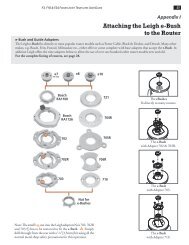Leigh Mortise and Tenon Jig Leigh Mortise and Tenon Jig - Leigh Jigs
Leigh Mortise and Tenon Jig Leigh Mortise and Tenon Jig - Leigh Jigs
Leigh Mortise and Tenon Jig Leigh Mortise and Tenon Jig - Leigh Jigs
You also want an ePaper? Increase the reach of your titles
YUMPU automatically turns print PDFs into web optimized ePapers that Google loves.
5/16" spiral<br />
upcut bit (with<br />
a 1/2" shank)<br />
<strong>and</strong> five 5/16"<br />
joint guides,<br />
which enable<br />
you to cut<br />
joints from<br />
1/2" to 1 1/2"<br />
in 1/4" increments. This<br />
second adjustment takes<br />
about 20 minutes, <strong>and</strong><br />
involves cutting a set of test<br />
joints.<br />
Cutting Joints<br />
In order to cut perfect joints it’s imperative that your stock is true<br />
<strong>and</strong> square, <strong>and</strong> it’s surfaces are smooth <strong>and</strong> free from milling<br />
marks. Form the habit of<br />
having the same side of<br />
the work pieces face<br />
against the clamp plate.<br />
It is also important to<br />
take care when marking<br />
the centres of your<br />
tenons <strong>and</strong> mortises; I<br />
found that a marking<br />
knife did a better job<br />
than a pencil. Patience <strong>and</strong><br />
consistency are the keywords<br />
when cutting joints, particularly<br />
for a production run.<br />
The actual process is pretty intuitive, <strong>and</strong> after a few test cuts, is<br />
fairly easy to remember.<br />
As the term implies, the “limit stops” (LR <strong>and</strong> FB) limit<br />
movement of the tabletop. You’ll adjust these before you rout<br />
your tenons. You’ll also use them before you rout the mortises, if<br />
your mortise work pieces are of different dimension than your<br />
tenon work pieces.<br />
The “aligning sight”, which you use in conjunction with the limit<br />
stops, enables you to accurately position your work piece. Once set,<br />
you’ll use the “table clamp” to lock the tabletop in place. The “joint<br />
guide” <strong>and</strong> “pin track” guide the router as it cuts the stock. Simple<br />
to remember, easy to use!<br />
Because the sub-base cutter hole is only about 1" diameter, it’s<br />
somewhat difficult to see the bit as it cuts stock, which for some<br />
folks might take a bit of getting used to. The dust port on the back of<br />
the jig does a pretty good job of picking up most of the debris,<br />
except when large stock blocks up the cutter opening.<br />
LR: left to right<br />
limit stops<br />
Joint Guide<br />
FB: front to back<br />
limit stops<br />
Aligning Site<br />
Visit our website at: www.canadianwoodworking.com<br />
Table Clamp<br />
Pin Track<br />
The clamp plate tilts up to 30° from vertical, <strong>and</strong> the side stop<br />
fence can be angled up to 45° left or right, enabling you to cut<br />
angled <strong>and</strong> compound joints. I did cut a number of offset, wide,<br />
twin, quadruple, <strong>and</strong> bridle joints without a hitch.<br />
Accessories<br />
As mentioned, the jig comes with matching 5/16" bit <strong>and</strong> guides.<br />
You can buy guides for 1/4", 3/8" <strong>and</strong> 1/2" tenon sizes. Matching<br />
bits can be bought from <strong>Leigh</strong> or any third-party source. By mixing<br />
different bit sizes <strong>and</strong> guides you can cut a total of 68 different joint<br />
sizes from an incredibly small 1/32" by 3/32" to as large as 1/2" by<br />
4 1/2". For a single tenon the maximum work piece size is 1 5/16"<br />
by 5 1/2", while for a quadruple tenon it’s 2 3/4" by 5 1/2".<br />
Impressions<br />
The FMT is one of the best shop accessories that I’ve seen in<br />
years. It enables anyone, from novice woodworker to seasoned<br />
shop pro, to cut faultless mortise <strong>and</strong> tenons. In a production<br />
environment it will pay for itself in increased productivity in a very<br />
short time. And best of all, the jig is easy to use. The photo examples<br />
show the first single <strong>and</strong> twin joints that I cut with the FMT.<br />
Marking <strong>and</strong> cutting a set of 16 single joints (5/16" by 3 3/4") took<br />
50 minutes. Each one was a perfect fit!<br />
Where to Get It<br />
The FMT is available from Lee Valley Tools (www.leevalley.com<br />
or 1-800-668-1807) for $1,059. A set of 1/4", 3/8" <strong>and</strong> 1/2" joint<br />
guides cost $99. The basic kit includes the jig, five 5/16" joint<br />
guides, a 5/16" spiral upcut bit (with a 1/2" shank) <strong>and</strong> a<br />
comprehensive instruction guide. For more information contact<br />
<strong>Leigh</strong> at 1-800-663-8932 or www.leighjigs.com.<br />
CARL DUGUAY is a writer <strong>and</strong> woodworker from<br />
Sidney, British Columbia 250-888-5067<br />
carl@finewoodworking.ca www.finewoodworking.ca<br />
8 PROJECTS PLANS TIPS JIGS TOOLS<br />
Restoring<br />
H<strong>and</strong> Planes<br />
Building<br />
Base Cabinets<br />
For Kitchen & Bath<br />
Wood Finishing<br />
Surface Preparation<br />
Blanket Box<br />
Attractive Storage Space<br />
Sleigh Bed<br />
Unique Bedroom Furniture<br />
PLUS: Tool Reviews,<br />
Dust Collection,<br />
Coming Events<br />
CanadianWoodworking.com<br />
AUGUST/SEPTEMBER 2003<br />
Vol.6, No. 4<br />
$4.95<br />
CANADIAN WOODWORKING 29
















